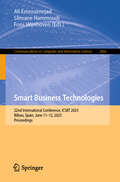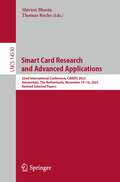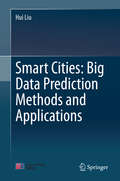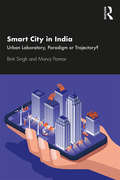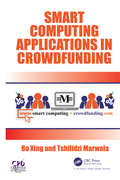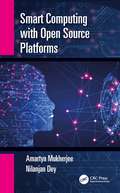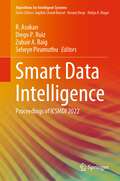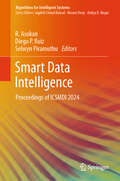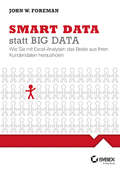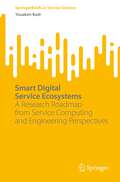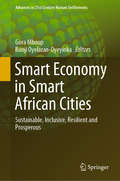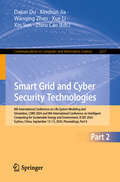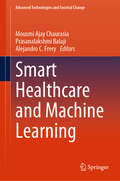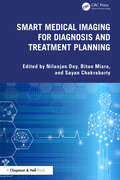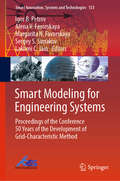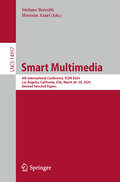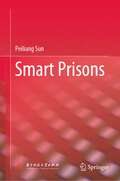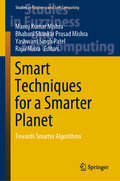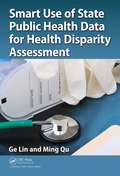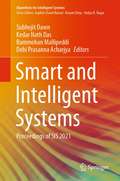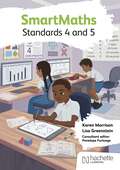- Table View
- List View
Smart Business Technologies: 21st International Conference, ICSBT 2024, Dijon, France, July 9–11, 2024, Revised Selected Papers (Communications in Computer and Information Science #2589)
by Ali Emrouznejad Slimane Hammoudi Fons WijnhovenThis book constitutes the refereed post proceedings of the 21st International Conference on Smart Business Technologies, ICSBT 2024, which took place in Dijon, France, during July 9–10, 2024. The 7 papers included in these proceedings were carefully reviewed and selected from 27 submissions. They focus on all aspects of foundational technological topics, such as technology platforms, internet of things, artificial intelligence, data science and web services, and application area needs and requirements, such as business processes, business intelligence, digital twins, value setting, and business strategy for manufacturing, service and trade domains.
Smart Business Technologies: 22nd International Conference, ICSBT 2025, Bilbao, Spain, June 11–12, 2025, Proceedings (Communications in Computer and Information Science #2666)
by Ali Emrouznejad Slimane Hammoudi Fons WijnhovenThis book constitutes the conference proceedings of the 22nd International Conference on Smart Business Technologies, ICSBT 2025 held in Bilbao, Spain, during June 11–12, 2025. The 19 full papers included in this book were carefully reviewed and selected from 39 submissions.They focus on the conference theme &“Artificial Intelligence and The Future of GenAI in Business&”, highlighting the transformative potential of Generative AI and its applications in the business world.
Smart Business and Technologies: Proceeding of the International Conference on Smart Business and Technologies (ICSBT’24) (Lecture Notes in Networks and Systems #1330)
by Mohamed Lazaar Souad Najoua Lagmiri Fouad Mohammed AmineThis book covers the theory, applications, and viewpoints on the most recent and upcoming advancements in the fields of complex processes, decision-making, control, and systems and networks. In the well-known lecture notes in networks and systems series, "Smart Business and Technologies" is the most recent entry. The cutting-edge research presented at the International Conference on Smart Business and technology (ICSBT'24) is compiled in this volume, which highlights creative solutions, new developments, and useful applications in the domains of advanced technology and smart business practices. For scholars, professionals, and students hoping to remain on the cutting edge of business innovation and technology breakthroughs, it is a vital resource. Numerous topics, including cyber-physical systems, artificial intelligence, data analytics, IoT-enabled solutions, autonomous systems, control systems, sustainable business models, digital transformation strategies, blockchain applications, smart supply chain management, customer experience optimization, predictive analytics, energy systems, robotics, smart cities, manufacturing, and more, are covered in the series' proceedings and edited volumes on systems and networks. These subjects provide insights into the methods and paradigms that propel advancement in smart business and technology sectors. They are enmeshed in interdisciplinary fields such as applied sciences, engineering, computer science, business, economics, and social sciences.
Smart Card Research and Advanced Applications: 22nd International Conference, CARDIS 2023, Amsterdam, The Netherlands, November 14–16, 2023, Revised Selected Papers (Lecture Notes in Computer Science #14530)
by Thomas Roche Shivam BhasinThis book constitutes the proceedings of the 22nd International Conference on Smart Card Research and Advanced Applications, CARDIS 2023, held in Amsterdam, The Netherlands, during November 14–16, 2023.The 13 full papers presented in this volume were carefully reviewed and selected from 28 submissions. They were organized in topical sections as follows: fault attacks; side-channel analysis; smartcards & efficient Implementations; and side-channel & neural networks.
Smart Cities: Big Data Prediction Methods and Applications
by Hui LiuSmart Cities: Big Data Prediction Methods and Applications is the first reference to provide a comprehensive overview of smart cities with the latest big data predicting techniques. This timely book discusses big data forecasting for smart cities. It introduces big data forecasting techniques for the key aspects (e.g., traffic, environment, building energy, green grid, etc.) of smart cities, and explores three key areas that can be improved using big data prediction: grid energy, road traffic networks and environmental health in smart cities. The big data prediction methods proposed in this book are highly significant in terms of the planning, construction, management, control and development of green and smart cities. Including numerous case studies to explain each method and model, this easy-to-understand book appeals to scientists, engineers, college students, postgraduates, teachers and managers from various fields of artificial intelligence, smart cities, smart grid, intelligent traffic systems, intelligent environments and big data computing.
Smart City in India: Urban Laboratory, Paradigm or Trajectory?
by Binti Singh Manoj ParmarThis book is a critical reflection on the Smart City Mission in India. Drawing on ethnographic data from across Indian cities, this volume assesses the transformative possibilities and limitations of the program. It examines the ten core infrastructural elements that make up a city, including water, electricity, waste, mobility, housing, environment, health, and education, and lays down the basic tenets of urban policy in India. The volume underlines the need to recognize liminal spaces and the plans to make the ‘smart city’ an inclusive one. The authors also look at maintaining a link between the older heritage of a city and the emerging urban space. This volume will be of great interest to planners, urbanists, and policymakers, as well as scholars and researchers of urban studies and planning, architecture, and sociology and social anthropology.
Smart Computing Applications in Crowdfunding
by Tshilidzi Marwala Bo XingThe book focuses on smart computing for crowdfunding usage, looking at the crowdfunding landscape, e.g., reward-, donation-, equity-, P2P-based and the crowdfunding ecosystem, e.g., regulator, asker, backer, investor, and operator. The increased complexity of fund raising scenario, driven by the broad economic environment as well as the need for using alternative funding sources, has sparked research in smart computing techniques. Covering a wide range of detailed topics, the authors of this book offer an outstanding overview of the current state of the art; providing deep insights into smart computing methods, tools, and their applications in crowdfunding; exploring the importance of smart analysis, prediction, and decision-making within the fintech industry. This book is intended to be an authoritative and valuable resource for professional practitioners and researchers alike, as well as finance engineering, and computer science students who are interested in crowdfunding and other emerging fintech topics.
Smart Computing with Open Source Platforms
by Nilanjan Dey Amartya MukherjeeFocuses on the concept of open source prototyping and product development and designing sensor networks and covers IoT base applications This book will serves as a single source of introductory material and reference for programming smart computing and Internet of Things (IoT) devices using Arduino with the use of Python It covers number of comprehensive DIY experiments through which the reader can design various intelligent systems
Smart Data Intelligence: Proceedings of ICSMDI 2022 (Algorithms for Intelligent Systems)
by Selwyn Piramuthu Zubair A. Baig R. Asokan Diego P. RuizThis book presents high-quality research papers presented at 2nd International Conference on Smart Data Intelligence (ICSMDI 2022) organized by Kongunadu College of Engineering and Technology at Trichy, Tamil Nadu, India, during April 2022. This book brings out the new advances and research results in the fields of algorithmic design, data analysis, and implementation on various real-time applications. It discusses many emerging related fields like big data, data science, artificial intelligence, machine learning, and deep learning which have deployed a paradigm shift in various data-driven approaches that tends to evolve new data-driven research opportunities in various influential domains like social networks, healthcare, information, and communication applications.
Smart Data Intelligence: Proceedings of ICSMDI 2024 (Algorithms for Intelligent Systems)
by Selwyn Piramuthu R. Asokan Diego P. RuizThis book presents high-quality research papers presented at 4th International Conference on Smart Data Intelligence (ICSMDI 2024) organized by Kongunadu College of Engineering and Technology at Trichy, Tamil Nadu, India, during February 2024. This book brings out the new advances and research results in the fields of algorithmic design, data analysis, and implementation on various real-time applications. It discusses many emerging related fields like big data, data science, artificial intelligence, machine learning, and deep learning which have deployed a paradigm shift in various data-driven approaches that tends to evolve new data-driven research opportunities in various influential domains like social networks, health care, information, and communication applications.
Smart Data Intelligence: Proceedings of ICSMDI 2025 (Algorithms for Intelligent Systems)
by R. Asokan Diego P. Ruiz Vasile-Daniel PăvăloaiaThis book presents high-quality research papers presented at 5th International Conference on Smart Data Intelligence (ICSMDI 2025) organized by Kongunadu College of Engineering and Technology at Trichy, Tamil Nadu, India, during January 2025. This book brings out the new advances and research results in the fields of algorithmic design, data analysis, and implementation on various real-time applications. It discusses many emerging related fields like big data, data science, artificial intelligence, machine learning, and deep learning which have deployed a paradigm shift in various data-driven approaches that tends to evolve new data-driven research opportunities in various influential domains like social networks, health care, information, and communication applications.
Smart Data statt Big Data: Wie Sie mit Excel-Analysen das Beste aus Ihren Kundendaten herausholen
by John W. Foreman Jutta SchmidtWelche Produkte kann ich meinen Kunden aufgrund ihrer vorherigen Käufe noch anbieten? Wie kann ich meine Absätze vorhersagen oder Kosten optimieren? Wie kann ich Kundenmails automatisch analysieren? Wenn Sie sich diese oder ähnliche Fragen stellen, finden Sie in diesem Buch die passenden Antworten. Es richtet sich an alle, die eine gewisse Menge Daten haben und ahnen, dass darin wertvolle Erkenntnisse schlummern, die aber nicht wissen, wie sie sie herauskitzeln können. Data-Science-Spezialist John Foreman zeigt Ihnen, wie auch kleinere Unternehmen von Big-Data-Ansätzen profitieren und dass Sie dafür nicht mehr benötigen als grundlegende Mathekenntnisse und ein Tabellenkalkulationsprogramm wie Microsoft Excel oder LibreOffice Calc. Nach ein paar nützlichen allgemeinen Hinweisen zu Excel lernen Sie an realistischen Businessbeispielen, mit welchen Verfahren Sie Kunden clustern, Dokumente klassifizieren, Investitionen und Gewinne optimieren, Prognosen über zukünftige Abverkäufe treffen und wichtige Ausreißer identifizieren. Alle Verfahren sind genauso verständlich wie unterhaltsam erklärt und damit Sie sie direkt selbst ausprobieren können, finden Sie alle Beispieldaten zum Download auf der Website des Verlags. Wenn Sie im Anschluss daran noch tiefer in die Datenanalyse einsteigen möchten, zeigt Ihnen ein kurzer Ausblick auf die Programmiersprache R, was noch alles möglich ist. So sind Sie optimal gerüstet und holen in Zukunft das Beste aus Ihren Daten heraus!
Smart Digital Service Ecosystems: A Research Roadmap from Service Computing and Engineering Perspectives (SpringerBriefs in Service Science)
by Youakim BadrThis book provides a holistic overview of the major advances that have been made in the context of Service Science with a focus on IT-enabled services. To address challenges in collaborative, social-centric, ad-hoc, dynamic and open environments, the book studies IT-enabled service systems from two distinct but complementary research perspectives: service engineering and service computing. From a service engineering view, the book shows how to apply a systemic approach to tackle social problems from holistic and multi-disciplinary perspectives by focusing on service systems and developing a service design framework, including socio-technical aspects, the service reference model, data-driven collaboration processes, the incremental design method, requirement propagation, and system adaptability with feedback loops. From a service computing view, the book introduces a service-oriented aided infrastructure to support IT-enabled service systems in ICT-facilitated environments and provide access to tangible and intangible resources in a trustworthy environment. The book offers a valuable companion and comprehensive reference guide for undergraduate and graduate students who want to learn about current concepts for designing and implementing service systems; and for researchers who want to identify future directions in build smart digital service ecosystems, integrating Internet of Things (IoT) and Artificial Intelligence (AI) and cyber-security. The book also appeals to developers who need to implement advanced services and want to capitalize on corresponding business models, customer-driven interaction, and scalable architectures.
Smart Economy in Smart African Cities: Sustainable, Inclusive, Resilient and Prosperous (Advances in 21st Century Human Settlements)
by Banji Oyelaran-Oyeyinka Gora MboupThis book highlights the use of information and communication technology (ICT) infrastructures in order to develop smart cities and produce smart economies in Africa. It discusses a robust set of concepts, including smart planning, smart infrastructure development, smart economic development, smart environmental sustainability, smart social development, resilience, and smart peace and security in several African cities. By drawing on the accumulated knowledge on various conditions that make cities smart, green, livable and healthy, it helps in the planning, design and management of African urbanization. In turn, it fosters the development of e-commerce, e-education, e-governance, etc. The rapid development of ICT infrastructures facilitates the creation of smart economies in digitally served cities and towns through smart urban planning, smart infrastructures, smart land tenure and smart urban policies. In the long term, this can reduce emissions of CO2, promote the creation of low carbon cities, reduce land degradation and promote biodiversity.
Smart Grid and Cyber Security Technologies: 8th International Conference on Life System Modeling and Simulation, LSMS 2024 and 8th International Conference on Intelligent Computing for Sustainable Energy and Environment, ICSEE 2024, Suzhou, China, September 13–15, 2024, Proceedings, Part II (Communications in Computer and Information Science #2217)
by Xin Sun Xue Li Dajun Du Xinchun Jia Wanqing Zhao Zhiru CaoThe five-volume set constitutes the thoroughly refereed proceedings of the 8th International Conference on Life System Modeling and Simulation, LSMS 2024, and of the 8th International Conference on Intelligent Computing for Sustainable Energy and Environment, ICSEE 2024, which were held during September 13-15, in Suzhou, China. The 34 papers presented were carefully reviewed and selected from over 496 submissions. The LSMS and ICSEE international conference series aim to bring together international researchers and practitioners in the fields of advanced methods for life system modeling and simulation, as well as advanced intelligent computing theory, methodologies, and engineering applications in achieving net zero across all sectors to tackle the global climate change challenge.
Smart Healthcare and Machine Learning (Advanced Technologies and Societal Change)
by Alejandro C. Frery Mousmi Ajay Chaurasia Prasanalakshmi BalajiThe book explores the convergence of healthcare and cutting-edge technology, making it a captivating subject for readers interested in future research. Smart healthcare with machine learning techniques offers a transformative paradigm that utilizes the power of new technology, data analytics, and interconnected devices to enhance the quality, efficiency, and accessibility of healthcare services. This involves leveraging Internet of Things (IoT) devices, wearable technology, and machine learning algorithms to monitor patient health, predict medical conditions, and offer personalized treatment recommendations. This innovative combination not only enhances diagnostics and treatment but also addresses the research challenges of healthcare access and delivery in an increasingly connected world. By exploring the synergy between smart healthcare and machine learning, the book helps to understand how these technologies can collaborate to revolutionize patient care and healthcare delivery. This book is an outcome with applications of future technologies to overcome the toughest humanitarian challenges from an engineering approach.
Smart Medical Imaging for Diagnosis and Treatment Planning
by Nilanjan Dey, Bitan Misra, and Sayan ChakrabortyThis book presents advanced research on smart health technologies, focusing on the innovative transformations in diagnosis and treatment planning using medical imaging and data analysed by data science techniques. It shows how smart health technologies leverage artificial intelligence (AI) and big data analytics to provide more accurate and efficient diagnosis and treatment planning. In search for innovative and novel methods and techniques for health technologies and medical data processing, the book • Discusses applications of Artificial Intelligence, Data Science, Machine Learning, Deep Learning, the Internet of Things, Big Data, Cloud Computing;• Includes use of electronic patient records in healthcare, analysis of big data in medical diagnosis, reliability, and challenges of EPR and EHR in smart healthcare;• Explores evolving techniques for smart healthcare, its application in medical imaging and prediction in the fields of treatment planning;• Provides recent studies in AI-driven healthcare technologies and medical imaging to outline insight into smart healthcare technologies;• Discusses the role of big data in smart healthcare, computing techniques for healthcare for medical diagnosis and treatment planning;• Encompasses the ethical and legal challenges of using smart healthcare and medical data.This book serves as a valuable reference for researchers working on smart health technologies. Researchers of medical imaging, artificial intelligence, and data science along with healthcare domain will find it a great resource as well.
Smart Modeling for Engineering Systems: Proceedings Of The Conference 50 Years Of The Development Of Grid-characteristic Method (Smart Innovation, Systems and Technologies #133)
by Lakhmi C. Jain Margarita N. Favorskaya Alena V. Favorskaya Igor B. Petrov Sergey S. SimakovThis book highlights the work of several world-class researchers on smart modeling of complex systems. The contributions are grouped into the four main categories listed below. · Numerical schemes construction for the solution of partial differential equations. · Numerical methods in continuum media mechanics problems. · Mathematical modeling in aerodynamics, plasma physics, deformable body mechanics, and geological hydrocarbon exploration. · Mathematical modeling in medical applications. The book offers a valuable resource for theoreticians and application scientists and engineers, as well as postgraduate students, in the fields of computational methods, numerical experiments, parallel algorithms, deformable solid bodies, seismic stability, seismic prospecting, migration, elastic and acoustic wave investigation, gas dynamics, astrophysics, aerodynamics, fluid dynamics, turbulent flows, hypersonic flows, detonation waves, composite materials, fracture mechanics, melting of metals, mathematical economics, medicine, and biology.
Smart Multimedia: 4th International Conference, ICSM 2024, Los Angeles, California, USA, March 28–30, 2024, Revised Selected Papers (Lecture Notes in Computer Science #14957)
by Stefano Berretti Hossein AzariThis book constitutes the refereed post-proceedings of the 4th International Conference on Smart Multimedia, ICSM 2024, held in Los Angeles, California, USA, in March 28–30, 2024. The 9 full papers, 8 special papers, 4 industrial papers, 3 late breaking papers, and 3 short papers presented were carefully reviewed and selected from 60 submissions. The papers are organized in the following topical sections: machine learning for multimedia; multimedia; special session on smart homes and cities - the future through smart technological innovations; multimedia processing; short and industrial papers; industrial trend; late breaking papers; special session: haptic and human machine interaction.
Smart Prisons
by Peiliang SunThis book aims to apply the new generation of information technology to the research and practice of prison management, promote the reform of prison security, fair law enforcement, educational correction and other management modes brought about by strengthening the police with science and technology, deepen the practice of administering prison according to law, and promote the modernization of prison governance system and governance capacity. This book is suitable for the personnel engaged in the management and informatization construction of prisons, drug rehabilitation centers, detention houses, and community correction institutions as professional book and is also suitable as the teaching, training, and reference book of criminal execution, prison management, community correction, judicial information technology, prison information technology, and other majors in the colledge of criminal justice.
Smart Techniques for a Smarter Planet: Towards Smarter Algorithms (Studies in Fuzziness and Soft Computing #374)
by Bhabani Shankar Mishra Manoj Kumar Mishra Yashwant Singh Patel Rajiv MisraThis book is intended to provide a systematic overview of so-called smart techniques, such as nature-inspired algorithms, machine learning and metaheuristics. Despite their ubiquitous presence and widespread application to different scientific problems, such as searching, optimization and /or classification, a systematic study is missing in the current literature. Here, the editors collected a set of chapters on key topics, paying attention to provide an equal balance of theory and practice, and to outline similarities between the different techniques and applications. All in all, the book provides an unified view on the field on intelligent methods, with their current perspective and future challenges.
Smart Use of State Public Health Data for Health Disparity Assessment
by Ge Lin Ming QuHealth services are often fragmented along organizational lines with limited communication among the public health–related programs or organizations, such as mental health, social services, and public health services. This can result in disjointed decision making without necessary data and knowledge, organizational fragmentation, and disparate knowledge development across the full array of public health needs. When new questions or challenges arise that require collaboration, individual public health practitioners (e.g., surveillance specialists and epidemiologists) often do not have the time and energy to spend on them. Smart Use of State Public Health Data for Health Disparity Assessment promotes data integration to aid crosscutting program collaboration. It explains how to maximize the use of various datasets from state health departments for assessing health disparity and for disease prevention. The authors offer practical advice on state public health data use, their strengths and weaknesses, data management insight, and lessons learned. They propose a bottom-up approach for building an integrated public health data warehouse that includes localized public health data. The book is divided into three sections: Section I has seven chapters devoted to knowledge and skill preparations for recognizing disparity issues and integrating and analyzing local public health data. Section II provides a systematic surveillance effort by linking census tract poverty to other health disparity dimensions. Section III provides in-depth studies related to Sections I and II. All data used in the book have been geocoded to the census tract level, making it possible to go more local, even down to the neighborhood level.
Smart and Intelligent Systems: Proceedings of SIS 2021 (Algorithms for Intelligent Systems)
by Kedar Nath Das Subhojit Dawn Debi Prasanna Acharjya Rammohan MallipeddiThis book is a collection of high-quality research papers presented at the International Conference on Smart and Intelligent Systems (SIS 2021), which will be held in Velagapudi Ramakrishna Siddhartha Engineering College (VRSEC), Andhra Pradesh, India, during February 25–26, 2021, in virtual mode. It highlights how recent informatics intelligent systems have successfully been used to develop innovative smart techniques and infrastructure in the field of modern engineering and technology. The book will also be of interest to those working in the field of computational intelligence, smart computer network and security analysis, control and automation system, cloud computing, fog computing and IoT, smart grid communication, smart cities, solar cell synthesis and their performance, green technology, and many more. The contents of this book prove useful to researchers and professionals.
SmartMaths Standards 4 and 5
by Karen MorrisonMaster All Levels of Primary Mathematics Through a Comprehensive Educational Framework. Boost the educational journey of every student with resources that are culturally relevant, accessible and engaging, available in both print and digital formats.· Cultivate mastery of key mathematical concepts through clear, straightforward explanations using step-by-step guidance and real-life examples.· Streamline SEA preparation from the start with a structured course. Beginning with Standard 1 and progressing seamlessly to a focused resource for Standards 4 and 5, prepare students for the SEA with extensive exercises and exam preparation materials that cater to diverse learning styles.· Engage with culturally relevant content authentically reflecting Trinidad and Tobago's local environments, cultures, and realities, developed and reviewed by local contributors and a Consultant Editor.
SmartMaths Standards 4 and 5
by Karen MorrisonMaster All Levels of Primary Mathematics Through a Comprehensive Educational Framework. Boost the educational journey of every student with resources that are culturally relevant, accessible and engaging, available in both print and digital formats.· Cultivate mastery of key mathematical concepts through clear, straightforward explanations using step-by-step guidance and real-life examples.· Streamline SEA preparation from the start with a structured course. Beginning with Standard 1 and progressing seamlessly to a focused resource for Standards 4 and 5, prepare students for the SEA with extensive exercises and exam preparation materials that cater to diverse learning styles.· Engage with culturally relevant content authentically reflecting Trinidad and Tobago's local environments, cultures, and realities, developed and reviewed by local contributors and a Consultant Editor.

